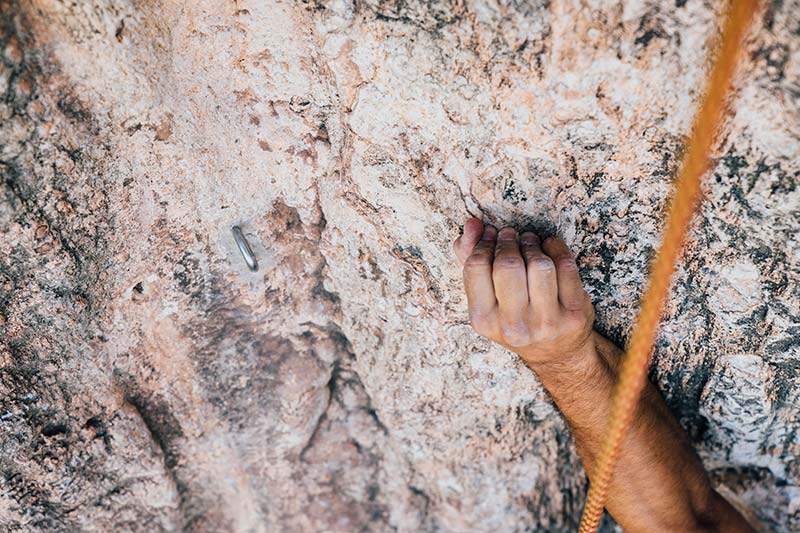If you’re getting into rock climbing, you may or may not have heard about the “dry rope vs non-dry rope” argument.
You’ll need to make many subjective decisions as you purchase climbing gear for yourself, and the dilemma of dry rope vs non-dry rope is just one of them.
After all, your climbing rope is literally your lifeline when you’re against a sheer rock or ice face, so the decision you make about which kind is best for you is a deeply personal one.
In this article, we’ll walk you through all the things you should think about when considering these two types of rope.
Waterproofing
The main difference between a dry rope and a non-dry rope comes down to waterproofing.
As a general rule, a non-dry climbing rope is a standard, uncoated climbing rope, while dry rope has some kind of water-repellent coating around the sheath, the core, or both.
When a non-dry rope gets wet, the fibers within it will absorb water and expand, weakening the integrity of the climbing rope.
While non-dry climbing rope is sufficient for any application that won’t involve getting it soaking wet, if a sudden rain comes or you’ll be climbing in snowy conditions, it could put your life in danger.
Dry rope, as the name suggests, is designed for use in moist conditions.
While the treatment of dry climbing rope can vary between manufacturers, there are generally three types: dry sheath, dry core, and a combination of the two.
Dry sheath rope gets a waterproof coating applied to the outside of the climbing rope only.
On the other hand, dry core rope has a water repellent coating applied to the rope’s core before the sheath gets wrapped around it.
Combination rope gets the coating applied to both the sheath and the core.
Keep in mind that different manufacturers can call their rope types by other names, such as double-coated dry rope instead of combination rope.
Additionally, while dry rope is designed to be water-resistant, no climbing rope is entirely waterproof.
Because of a climbing rope’s fibrous nature, it’s always possible for water to intrude and degrade the rope’s quality.
However, it’s more difficult for water to penetrate a treated climbing rope than an untreated one.
Durability
Obviously, a dry rope is meant to be much more durable in wet conditions.
However, in practice, that water-resistant coating on the outside of the dry rope makes it more durable in other situations, too.
Many climbers find that, while dry climbing ropes are more expensive, they tend to hold up to wear and tear better. They also take longer to fray.
However, as you search for dry ropes, watch out for cords with other coatings on them.
Some companies sell climbing ropes with protective coatings that help the climbing rope last longer or stand up to more abuse.
While these durability coatings are useful, they won’t help as much (or at all) under wet conditions.
In many cases, a dry rope also just feels better to use than a non-dry climbing rope. It’s easier to manipulate and feels more responsive.
That can make all the difference when you’re out on a climb.

However, just because dry rope does better in wet conditions doesn’t mean you can’t use non-dry climbing rope, either.
Despite the name, a non-dry climbing rope can get wet; for example, you’ll want to wash your climbing ropes every so often to keep them functional.
However, it’s never a good idea to climb with any rope – non-dry or otherwise – while it’s saturated.
Additionally, it’s essential to know that the exterior coating on a dry rope will wear off over time. It will wear more quickly on areas subject to friction.
If you notice that your dry rope doesn’t repel water like it used to, it may be time to retire it to indoor climbing only.
The core of a treated rope will understandably hold up longer than the sheath will under the same conditions.
However, even this interior water-repellent layer will eventually wear away from use. How long these coatings last depends on the quality of the rope and the manufacturer.
Cost
The cost difference of dry rope vs non-dry rope is significant, but not enough to put the price out of reach.
In fact, the cost difference between dry and non-dry climbing rope starts at around $20-$30, which should be easily affordable for any new climber.
However, because of the variability in quality and type among dry ropes, that cost difference can climb much higher based on length, number of coatings, types of coatings, and more.
For example, a double-coated combination rope with both a dry sheath and a dry core will cost more than a single-coated climbing rope with just the sheath or core coated.
In comparison, non-dry rope tends to be similar in price across the board, except for increased cost based on length.
FAQ
Do you have any lingering thoughts about the question of dry rope vs non-dry rope?
If so, we may be able to answer them in this FAQ section.
Can Non-Dry Rope Get Wet?
Both dry rope and non-dry rope can get wet, but it’s not ideal for them to get wet when you’re out climbing.
Climbing ropes should only be used when they are dry unless you’re in an emergency situation and have no other choice.
What Does Dry Rope Mean?
Contrary to what you might think, a dry rope isn’t a rope that must stay dry, but rather a cord that has been coated with a water-resistant layer to help it stay dry.
What Does Non-Dry Rope Mean?
A non-dry rope is the opposite of a dry climbing rope. It hasn’t been treated with any water-repellent chemicals, so it’s not a smart choice for climbing in wet or icy conditions.
However, a non-dry rope is fine for indoor climbing and good-weather outdoor climbing.
Final Thoughts
Regardless of which climbing rope you choose, we hope that this article on dry rope vs non-dry rope has cleared some things up for you.
After all, the names of these types of climbing ropes can be confusing.
image license: Freepik
